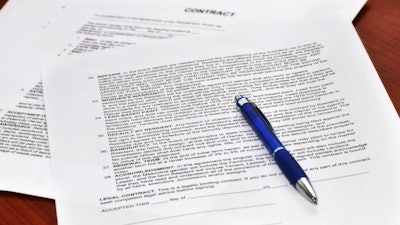
The primary reason that bad agreements exist between distributors and suppliers is because both parties agree to them. Parties are often under pressure to set up a new sales partnership quickly, and it is amazingly easy to agree to a bad one. Ensuring that you sign only a good agreement requires work. As you embark on the journey of setting up a new sales partnership, here are eight tips to ensure desirable results.
Always perform due diligence before negotiating
Lack of due diligence is a leading cause of failure of relationships between distributors and suppliers. During courtship, distributors and manufacturers often see the best attributes while ignoring undesirable traits or poor qualities of their prospective partners. When no one performs adequate due diligence, parties will discover unfamiliar problems after the relationship begins. Meet with several customers, partners and competitors and ask lots of questions about your future partner. If you skip this process, you will not detect poor practices, services or qualities until after the contract is in full effect. Negative inputs gathered while conducting due diligence can be disappointing, but those same revelations gathered once the contract governs the relationship can be shocking and costly.
Compare the draft with proven industry contracts
Many mistakes are the result of one partner trying to gain advantage over the other by inserting a bias into the contract favoring the party with greater experience. Here are three methods to level the playing field prior to negotiation. First, ask for help from friends from within the industry. Although it is unlikely that a direct competitor would lend you a copy of its distribution agreement, friends at indirect competitors usually have little fear of sharing an agreement that has proven over time to be free of problems. Second, ask for a model agreement from an industry or distribution trade association. A model is a good baseline with which to compare agreements. Third, if trying to sign a distribution contract in a foreign market, exploit the foreign network. There are American embassies with commercial sections, and American chambers of commerce around the world. If your foreign subsidiary doesn’t yet have a connection, start one at once. Costs are trivial, and the benefits extend far beyond learning how to negotiate a distribution agreement.
The contract should start only with the distributor’s established territory
The initial territory should define the geography with which the distributor has an established presence. It is not prudent to assign a larger territory and hope for the best. A better policy is to open a new distribution relationship in the proven territory and work on expansion after results suggest an expanded geography is wise.
Make the contract terminable for convenience by both parties
Most distributor agreements involving seasoned distributors and manufacturers allow for termination for cause and convenience. Partners often disagree over the presence of or responsibility for cause. When an agreement allows termination for convenience, a partner wishing to disengage from the agreement serves Notice of Termination with 30-day notice. Parties may choose a longer period between notice and effective termination proportional to the length of service. With a convenience clause, there is no need to argue about cause and responsibility. More important, the relationship does not end in litigation. The distributor and manufacturer can focus on their respective customers and businesses without consuming management time, corporate focus and financial resources on attorneys and courts.
Insist on having the distribution agreement reviewed by a legal professional and a sales professional
A major cause that leads suppliers and distributors into litigation upon termination is often a poorly worded agreement. Sometimes attorneys review the contract. Sometimes sales managers or executives review the contract. Results are best when both a legal professional and a seasoned sales manager review the distributor agreement simultaneously. When a legal professional and not a seasoned sales manager reviews the agreement, the resulting agreement can be legally acceptable, but commercially ineffective. When a seasoned sales manager and not an attorney review the contract, the resulting agreement can be commercially effective, but legally unacceptable. However, when an attorney and a sales professional review simultaneously, the probability of litigation upon termination diminishes greatly.
Never be afraid to walk away from an agreement you don’t like
By the time that you and your potential sales partner start passing draft agreements back and forth, your partner has made the decision to engage with you. If you cannot make a deal that is satisfactory, do not force the issue and agree to a bad contract. You will not be able to optimize sales with a partner with which you are engaged through an undesirable agreement. Do not fight it. Seek an alternative partner that appreciates the terms and conditions you consider important.
If you believe that specific terms or conditions are important, get them in writing
Termination always brings disappointment and stress. If your potential sales partner chooses to end the distribution contract, you will have a formidable challenge arguing over an “industry standard or practice” that is neither written in your contract nor an industry model agreement. Avoid disappointment and stress by inserting all terms and conditions important to you before signing the contract. If you choose to avoid inserting all important terms and conditions into the contract before signing, prepare for disappointment and stress.
Include semiautomatic renewal for the initial and subsequent terms of the contract
Semiautomatic renewal prevents the possibility of misunderstanding if the parties continue to work together after expiration of the term. Such misunderstanding often leads to litigation upon termination. Further, semiautomatic renewal leads both parties to review the contract annually. Each review alerts both parties that they have an opportunity to amend the agreement.






















